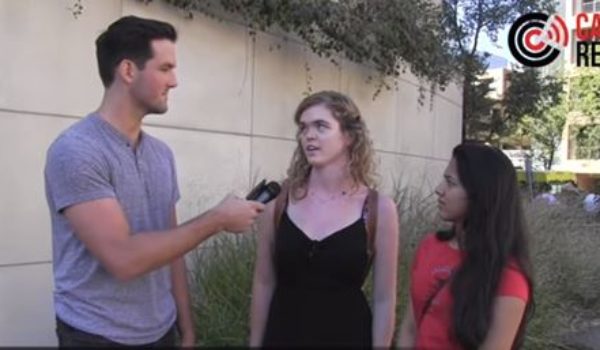
Racial quotas are unpopular. Yet criticizing them can be risky, because some liberals will insinuate that you are a racist for doing so.
A recent example is the reaction to the hiring of the Washington lawyer and LU contributor Hans Bader by the Education Department. Bader, a one-time civil-rights lawyer, had criticized the Obama-era Education Department for pressuring schools to have racial quotas in school discipline, including in posts at this very blog.
Bader’s hiring provoked a sour response from RiShawn Biddle at the liberal blog “Dropout Nation.” In an Oct. 18 blog post with a number of obvious factual errors, Biddle called Bader’s hiring “the latest example of [Education Secretary Betsy] DeVos’ aiding and abetting of bigotry.”
Will this presidential election be the most important in American history?
But opposing racial quotas is not bigotry. In fact, racial quotas in school discipline are illegal. As Bader pointed out, a federal appeals court ruled in 1997 that was illegal to order a school district not to suspend or refer for discipline a “higher percentage” of black students than white students. (People Who Care v. Rockford Board of Education (1997)).
Another federal appeals court found no racism in the fact that blacks were suspended at a much higher rate, declaring that it would be “absurd” to have a racial discipline quota, and that “disparity” in discipline rates “does not, by itself, constitute discrimination.” (Belk v. Charlotte Mecklenburg Bd. of Educ. (2001)).
Some studies, such as a 2014 study in the Journal of Criminal Justice, have concluded that the higher black suspension rate simply reflects higher rates of misbehavior by black students, who disproportionately come from low-income single-parent households (both poverty and out-of-wedlock births are linked to higher rates of misbehavior in school, as government agencies have pointed out. The homicide rate among black teens is ten times as high as among white teens, as noted in the Minneapolis Star-Tribune and National Review.).
Bader pointed out the problem with quotas. He explained that it was unrealistic to expect schools to suspend black students at the same rate as whites, when they do not misbehave at the same rate. The Obama administration, by contrast, told schools in 2014 that it was presumptively illegal for schools to discipline blacks at a higher rate than whites, even when the higher rate was due solely to “neutral,” and “evenhanded” application of discipline rules, which more black or minority students violated. (By “presumptively” illegal, I mean illegal unless the school could somehow convince civil-rights bureaucrats that its rules were essential enough to justify the “disparate impact”).
The Obama administration claimed this was a valid interpretation of its “disparate impact” regulations under Title VI, the civil-rights statute governing America’s schools.
But as Bader explained, this was a strange reading of those regulations, regulations themselves of dubious legality in a light of a 2001 Supreme Court decision:
The Supreme Court ruled in Alexander v. Sandoval (2001) that disparate impact doesn’t violate Title VI, only ‘intentional’ discrimination does. The Education Department elsewhere has claimed that while the Title VI statute itself doesn’t reach disparate impact, regulations under it can and do (an idea that the Supreme Court decision did not explicitly reject, but cast serious doubt on, by describing it as ‘strange‘ in footnote 6 of its opinion), but clearly the statute itself does not.
Moreover, the Obama-era Education Department just ignored the fact that any findings of “disparate impact” are supposed to take into account rudimentary qualifications, and a higher black suspension rate may just reflect that more blacks than whites are qualified for a suspension due to their behavior. (See the Supreme Court’s 1989 decision in Ward’s Cove Packing Co. v. Atonio).
Biddle, who is not a lawyer, claims that the 2001 Supreme Court decision cited by Bader has been “kibboshed” by a 2015 Supreme Court decision that did not even mention it, and had nothing to do with schools. As Biddle put it:
The ability of the federal government to weigh in on disparate impact was settled three years ago when the U.S. Supreme Court ruled in Texas Department of Housing and Community Affairs v. Inclusive Communities Project that the federal government could address such matters. While the ruling focused on housing, the high court’s ruling effectively kibboshed a previous opinion, Alexander v. Sandoval, that Bader often uses in his arguments against federal oversight on school discipline matters. Put simply, disparate impact is now legally recognized as a form of racism.
Biddle is wrong: The Supreme Court and other courts continue to follow the very decision he claims was overruled, Alexander v. Sandoval. For example, in a 2017 decision, a liberal federal appeals court in New York recognized that minorities cannot sue for “disparate impact” under Title VI, and that Title VI “prohibits only intentional discrimination.” (Joseph v. Metropolitan Museum of Art).
As controlling legal authority, it cited the very Supreme Court decision decision Biddle claims was “kibboshed” (Alexander v. Sandoval), showing it is still good law. The fact that Congress passed a law against “disparate impact” in housing projects hardly says anything about whether it intended to ban “disparate impact” in schools under a completely different statute (Title VI).
Biddle also claims that another statute (Title IV) bans racial disparities, but that law only gives the Justice Department the ability to sue over violations of students’ constitutional and equal-protection rights, and the Supreme Court ruled in 1976 and 1979 that only intentional discrimination violates such rights, not “disparate impact.”
Humorously, Biddle claims that Bader has “spent little time on studying school discipline and other civil rights issues.” But as Politico reported, “Bader previously worked at the Center for Individual Rights,” a law firm that litigated many civil-rights cases, “and at the Education Department’s Office for Civil Rights during the George W. Bush administration.” Bader’s work at CIR included multiple Title VI cases. It also included representing a black student-athlete who was sued along with the college he attended over a school-disciplinary matter. The Supreme Court ruled in favor of the student represented by Bader, striking down as unconstitutional the law used by another student to sue Bader’s client.
Bader has frequently written about civil-rights issues in recent years, including filing amicus briefs in the Supreme Court and other courts. And as liberal Education Week reports, “He’s written numerous opinion pieces and letters to the editor at major newspapers on the Obama education department’s approach to discipline.”
Biddle also lobs a false insinuation of nepotism against Bader. He writes that Bader is “a former scholar at the Competitive Enterprise Institute (and brother of its current president).” The Competitive Enterprise Institute, where Bader worked until recently, is headed by Kent Lassman, who appears to be completely unrelated to Hans Bader. It was led in 2012 by Lawson Bader, who was publicly described at the time as “unrelated” to Hans Bader by CEI scholars such as Ryan Radia.
Biddle’s anger at Bader may reflect the mistaken assumption that “veiled” discrimination can only be challenged under disparate-impact regulations, whose validity in schools Bader questions. He erroneously thinks that only disparate-impact rules can be used to remedy discrimination that is not “overt” but which “incidentally or deliberately discriminate against poor and minority children.”
But whether discrimination is “overt” or not has nothing to do with whether it is intentional. Hidden racism is often quite intentional and deliberate (like a secret policy to never hire blacks).
The Supreme Court allows intentional discrimination to be proven entirely through circumstantial evidence. After all, intentional racial discrimination is illegal, so racists will naturally do their best to hide it. This has nothing to do with whether such discrimination is intentional: neutral, even handed policies that have an unintended “racially disparate impact” on blacks are often quite open and public (such as a state’s official policy of requiring teachers to pass a colorblind teacher-certification exam that more blacks than whites fail).
The Education Week story about Bader’s hiring also seems to misunderstand the law, and when discrimination is legally deemed “intentional” rather than merely “disparate impact.” It suggests that disparate impact is needed when “data” shows blacks are “facing harsher punishments for the same rule violations compared to their peers.”
But if blacks really are facing harsher punishments for the very same offense, that is deemed “intentional” discrimination because blacks are actually being treated differently as individuals. Statistics can be used to prove a pattern of intentional discrimination, although that requires a greater consideration of qualifications and merit-based factors than proving mere disparate impact.
Claims that schools are discriminating against black students are often based on the argument that blacks are more often suspended for “subjective” offenses than for “objective offenses.” This claim is just false: As a legal white paper co-authored by Bader points out, the Obama Education Department’s 2014
guidance also discusses the subjectivity of certain offenses, and speculates that this could result in them being enforced more harshly against blacks. But that is not usually the case. A federal appeals court noted that subjectivity is not the reason blacks are suspended at higher rates than whites [in Coalition to Save Our Children v. State Bd. of Educ. of State of Delaware (1996)]. Indeed, blacks are suspended at even higher rates for “very objective” offenses than “subjective” ones.23 This finding belies the claims of academics like Russell Skiba, cited by DoEd,24 who claims that blacks are more likely to be sent to the principal’s office for “subjective” offenses, while whites are more likely to be sent for “objective” offenses. Skiba reached this dubious conclusion by arbitrarily labeling vague offenses as “objective” when they were often committed by whites (such as “obscene language”), and objectively harmful offenses as “subjective” when they were committed heavily by blacks (such as “threats”).25




